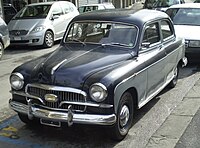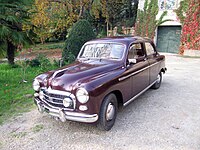Fiat 1400 and 1900
| Fiat 1400 Fiat 1900 | |
|---|---|
 1951 Fiat 1400 Berlina | |
| Overview | |
| Manufacturer | Fiat |
| Also called |
|
| Production | 1950–1958 1954–1961 (Yugoslavia) 1953–1959 (Austria) |
| Assembly | Heilbronn, West Germany (Neckar Automobilwerke) |
| Designer | Dante Giacosa[2] |
| Body and chassis | |
| Body style | |
| Layout | Front-engine, rear-wheel-drive |
| Related | SEAT 1400 |
| Powertrain | |
| Engine | |
| Transmission | 4- and 5-speed manual |
| Dimensions | |
| Wheelbase | 265 cm (104.3 in)[3] |
| Length | 424 cm (166.9 in)[3] |
| Width | 166 cm (65.4 in)[3] |
| Height | 153 cm (60.2 in)[3] |
| Kerb weight | 1,150–1,250 kg (2,540–2,760 lb) |
| Chronology | |
| Predecessor | Fiat 1500 |
| Successor | Fiat 1300/1500 (1400) Fiat 1800/2100 (1900) |
The Fiat 1400 and Fiat 1900 are passenger cars produced by Italian automotive manufacturer Fiat from 1950 to 1958 and from 1952 to 1959 respectively. The two models shared body and platform, but while the 1.4-litre 1400 was Fiat's intermediate offering, the upmarket 1900 had an enlarged 1.9-litre engine and more luxurious trim and equipment, to serve as flagship in the manufacturer's range.
The 1400 marked Fiat's first all-new postwar model, its first unibody car, and its first passenger car offered with a diesel engine. It also was the first passenger car produced by Spanish manufacturer SEAT and by Yugoslavian manufacturer Zastava.
History
The Fiat 1400 was introduced at the 1950 Geneva Motor Show. It was the first unibody Fiat automobile. In 1953, the introduction of a diesel version with a 1900 cc engine marked another Fiat first, although the diesel version was known as the 1400 Diesel.
Also in 1953, the 1400 entered production in Spain as the SEAT 1400, the first model produced by SEAT. The following year it also became the first passenger car produced by Crvena Zastava in FNRY,[4] the Zastava 1400 BJ. Equipped with a 2.0 litre Steyr engine, it was produced as "Steyr 2000" by Steyr-Daimler-Puch AG in Austria from 1953.
The Fiat 1900, introduced in 1952, was an upmarket model that used the same body as the 1400, but came with a 1.9 litre engine and more standard features. The petrol-engined Fiat 1900 A, introduced in 1954, now offered a claimed 70 bhp.[5] Unusually for that time, it featured a five speed column shifted manual transmission.[5] It also offered a hydraulically operated clutch, Fiat's first tentative foray into automatic transmissions.[6]
Features
- The engine had a 1.4 L capacity and a power output of 44 hp (33 kW) at 4400 rpm.[3]
- The larger engine offered from 1952 had a 1.9 L capacity and a power output of 70 CV (51 kW) at 4400 rpm.[5]
- It had a maximum speed of 120 km/h (75 mph) (1400 cc version).
- Unloaded weight of 1,120 kg (2,469 lb).
- Hand brake handle under instrument panel,
- Retaining loops for front seat passengers at the roof and at the backrests,
- Armrests in the doors
- Fuel filler access was through a trap door in the floor of the trunk/boot, thus keeping the fuel safe once the car was closed and locked[7]
- The 1900 came standard with a radio and a rudimental "trip computer" that showed the average speed.[8]
About 179,000 1400s and 19,000 1900s were built.
A 1400 cc model tested by the British magazine The Motor in 1950 had a top speed of 74.4 mph (119.7 km/h) and could accelerate from 0-60 mph (97 km/h) in 35.7 seconds. A fuel consumption of 24.2 miles per imperial gallon (11.7 L/100 km; 20.2 mpg‑US) was recorded. The car was never sold in the UK, but the Italian market price would have equated to approximately £750 including taxes.[3] Having eulogised the performance and "quite exceptional...top gear flexibility", British journalists went on to praise the "astonishing silence, smoothness and comfort provided by the vehicle", highlighting various "unique features designed to prevent the transmission of noise and vibration to the passengers".[7] Great use was made of rubber and of "a sound-proofing compound...liberally coated...[on the car's]...integral structure".[7]
The Motor tested a 1901 cc diesel model in 1954 and recorded a top speed of 63.8 mph (102.7 km/h), acceleration from 0-60 mph (97 km/h) in 45.2 seconds and a fuel consumption of 33.9 miles per imperial gallon (8.3 L/100 km; 28.2 mpg‑US). The car was not at the time available on the UK market but a price in Italy of 1,545,000 Lire was quoted which they worked out as equivalent to £909.[9]
Models
| Model | Engine | Displacement | Power | Fuel system |
|---|---|---|---|---|
| 1400 | straight-4 ohv | 1395 cc | 44-56 hp | single carburetor |
| 1400 D | straight-4 ohv | 1901 cc | 40 hp | diesel |
| 1900 | straight-4 ohv | 1901 cc | 60-80 hp | single carburetor |
-
Fiat 1400 Berlina (1956)
-
Fiat 1400 Cabriolet
-
Fiat 1900 A Berlina
-
Fiat 1900 B Gran Luce
References
- ^ Jacobs, A. J., Automotive FDI in Emerging Europe, p. 297
- ^ Bulmer, Charles (12 June 1971). "Dante Giacosa: From wartime to the present day, Paul Frère concludes his profile of a great engineer". Motor. 3597: 20–22.
- ^ a b c d e f "The Fiat 1400 saloon". The Motor. 13 December 1950.
- ^ "Zastava Automobiles: the 1950s". zastavanacionale.com. Archived from the original on 2 July 2014.
- ^ a b c "Vor 20 Jahren: Verbesserter Fiat". Auto, Motor und Sport. 1974 (9): 21. 27 April 1974.
- ^ Mazzocchi, Gianni, ed. (March 1979). "Fiat "Ritmo 75 CL" Automatica". Quattroruote (in Italian). 24 (280). Milan, Italy: Editoriale Domus: 82.
- ^ a b c "Fiat 1400 Saloon (road test)". Autocar. 17 March 1950.
- ^ "FIAT 1900: l'illusione americana" [Fiat 1900: the American Illusion] (PDF). autoemotostoriche.it (in Italian). p. 4. Retrieved 12 June 2014.
- ^ "The Fiat 1400 Diesel". The Motor. 13 January 1954.
External links
- Fiat 1400, Fiat 1400 A and B history at zuckerfabrik24.de (in German)





